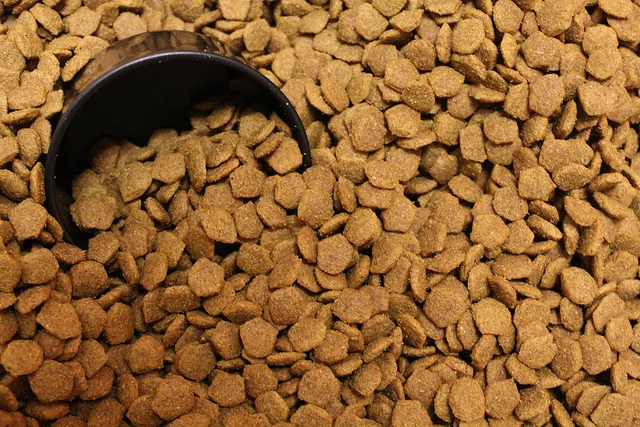Key Takeaways
- Not all dog food is created equal.
- Trendy foods aren’t always the best option.
- A dog’s ideal diet may vary, based upon their life stage and individual health factors.
- Your veterinarian is the best source of nutritional information.
Table of Contents
It’s easy to spoil your pup with toys, beds, and treats, but the best way to show your pet you care is by keeping him healthy. While vaccinations and parasite preventions are key factors in your dog’s health, nutrition is just as important. It’s important to make sure you’re feeding your pet the best dog food for his age, size and dietary needs. This requires doing careful research and consulting your dog’s veterinarian.
While it may be tempting to gravitate towards a food with attractive packaging and appealing advertising, the truth is that advertising can be misleading. Some owners are attracted to feeding human food, but that can lead to chronic conditions like obesity and pancreatitis. Finally, some owners consider raw diets, but these diets have been shown to increase the risk of foodborne disease.
What Makes a Dog Food “Good?”
A high-quality dog food is one that will meet all of your dog’s nutritional needs and support their overall health. A high-quality diet not only contains all of the required nutrients for your dog’s life stage, it also contains these nutrients in the correct ratios and in a form that is easily digested and absorbed. A high-quality diet may also contain additional ingredients, beyond what is strictly required, to further support your dog’s health.
Selecting the best possible dog food requires a bit of research into both the diet itself and the company that manufactures that diet. Any dog food manufacturer can create a dog food recipe that sounds wholesome and place an appealing label on that diet. A good dog food manufacturer, however, goes a step further. They take the time to conduct research on the needs of the pets that will eat their diets, including both healthy pets and pets with specific medical conditions. This research allows the manufacturer to understand the needs of the pets eating their diet, which is essential to formulating an optimal diet.
Feeding trials also play a role in developing a high-quality diet. These feeding trials involve feeding a diet to a group of dogs, in a controlled laboratory setting, for a period of at least six months. The dogs’ health is assessed during and after that test, including both physical exam parameters and blood tests. While no feeding trial can provide a perfect assurance that a diet will work for every dog, these are the best tool that we have available for assessing the real-world performance of a given dog food.
How to Read a Dog Food Label
When selecting a dog food, it’s important to read the label carefully. The Association of American Feed Control Officials (AAFCO) sets guidelines regarding pet food labels. That means that all labels are required to contain a similar set of information.
When you look at the front of a bag or can of dog food, much of the information you will see relates to marketing claims. Many dog food brands use fancy descriptives like gourmet, premium, all-natural, human grade, and holistic. Unfortunately, these terms are relatively meaningless, and manufacturers are not required to back them up. While this information may seem helpful, it actually doesn’t tell you much about the diet. Instead, it’s best to flip the bag or can over. The important information is typically located on the back of the packaging.
The most important part of a dog food label is the nutritional adequacy statement. This statement tells you whether the diet is intended to serve as a complete diet or as a treat. It also tells what species (dog or cat) and life stage (puppy, adult dog, senior dog, or all life stages) the food is intended for. For example, you may see a nutritional adequacy statement that says, “Animal feeding tests using AAFCO procedures substantiate that X Dog Food provides complete and balanced nutrition for adult dogs.” This tells you that this food has been through feeding trials (good news!) and that it has been shown to meet the nutritional needs of adult dogs. This is great news if you’re buying the food for an adult dog, but this diet may not be adequate for a growing puppy. Some foods have a nutritional adequacy statement saying that they are intended for “intermittent or supplemental feedings.” These diets are not nutritionally complete and cannot be used as your pet’s sole source of nutrition, even if the words and images on the front of the label suggest they are intended to be used as a complete diet.
In addition to the nutritional adequacy statement, a dog food label also contains the following information:
- Ingredient list
- Guaranteed analysis (nutrient levels)
- Feeding directions
Feeding directions are certainly essential information because they help you determine how much to feed your dog. Ingredient lists can be beneficial if your dog has a known food allergy, allowing you to avoid certain ingredients. Guaranteed analysis is typically less helpful; as long as the food provides complete and balanced nutrition (as stated in the nutritional adequacy statement), you can be confident that the nutrient levels in the guaranteed analysis will be appropriate.
Interestingly, you will not typically find calorie counts listed on a dog food label. Use the label’s feeding directions as a starting point, adjusting your dog’s food intake up or down as needed to maintain a healthy body weight.
Find the Best Dog Food Brands

Many pet parents’ top priority is finding a dog food that fits their budget. While it’s true that pet supplies can be pricey, there are many ways to get healthy dog food at an affordable price. High-quality diets are available at a variety of price points; you don’t necessarily need to purchase the most expensive food to ensure your dog’s health. (One exception worth mentioning: prescription diets. These diets are expensive, but there may not be a cheaper option to treat some medical conditions.) Whether you prefer to shop at a pet boutique or a big-box store, there is likely an available dog food that will meet your dog’s need without breaking the bank.
Talk to your veterinarian about your dog’s diet, including the brand that you’re considering. Veterinarians receive nutritional training during veterinary school, and typically stay up-to-date on nutritional advances through veterinary journals and continuing education conferences. Your veterinarian can help you select an appropriate brand of dog food for your pet, depending on your family’s preferences and budget.
Best Dog Food for Puppies

Picking a healthy dog food is a high priority for puppies, whose growing bodies and minds need proper nutrition. Puppies begin eating small amounts of solid food at about four weeks old, and they are fully weaned from their mothers at roughly six weeks old. From that time on, your puppy’s sole source of nutrition should be a high-quality puppy food (plus occasional treats, as needed for training). A nutritional deficiency or imbalance can affect puppies’ teeth, eyes, nails, fur, and overall growth for life, making it essential to select the best puppy food possible.
When selecting a diet for your puppy, it’s important to check the food’s nutritional adequacy statement. Ensure that you are purchasing a food developed specifically for puppies, because their needs often differ significantly from the needs of adult dogs. It’s also a good idea to ask your vet for their recommendation, especially since you’ll be a regular at the office getting all your puppy’s vaccines.
Best Dry Dog Food
There are many upsides to feeding your pet dry dog food, including convenience, cost, and cleanliness. Some dry dog foods are also formulated to help clean your dog’s teeth as they chew.
Don’t be fooled by marketing hype, though. Remember that many of the terms used on the front of the bag are meaningless. Instead, pay attention to the diet’s nutritional adequacy claims. Look for a complete and balanced diet that is appropriate for your dog’s life stage. Ensure that the food is made by a reputable manufacturer that performs ongoing research and conducts feeding trials. Talk to your veterinarian for further guidance.
Best Wet Dog Food
While many owners prefer dry dog food due to convenience, other dog owners prefer wet food. Wet foods can be especially beneficial for dogs that are picky eaters, as well as for dogs with dental disease that prohibits them from chewing dry food.
Selecting the best wet dog food is similar to selecting a high-quality dry dog food. Do your best to tune out trendy marketing terms, like “organic,” “grain-free,” and “all-natural.” Instead, evaluate the manufacturer’s research and quality control, looking for a diet that has been demonstrated to be complete and balanced for your dog’s life stage through the use of feeding trials.
Best Dog Food for Large Breeds
If you own a large breed dog, you’re probably familiar with the unique risks that can accompany these breeds. While large breeds are susceptible to many of the same conditions as smaller breed dogs, they are also at increased risk of a variety of orthopedic conditions, including arthritis.
Feeding a diet intended for large breed dogs can help to maximize your dog’s joint health. This is especially important during puppyhood, when a large breed puppy food can reduce the risk of abnormal skeletal growth that contributes to bone disease. Continuing to feed a large breed food during your dog’s adult and senior years can further reduce their risk of joint disease, as many of these diets contain glucosamine and other nutraceuticals (supplements) to support joint health.
Best Dog Food for Small Breeds
Like large breed dogs, small breeds have their own unique needs. Just imagine a tiny Chihuahua trying to chew a huge piece of large breed kibble! Small breed dogs do best with a diet that is designed specifically for them. Small breed dog foods often contain smaller pieces of kibble, making the diet easier for small dogs to chew with their smaller jaws and teeth.
Diets intended for small breed dogs may also be more calorie-dense and nutrient-dense than some large breed foods, to compensate for small breed dogs’ small stomachs and speedy metabolisms.
Best Dog Food for Allergies

For pups with food intolerances and allergies, finding the best dog food that meets their medical and nutritional needs can be tricky.
Food allergies involve an immune response to one or more ingredients in a food. These reactions typically occur to the proteins within a diet, and they can develop at any point in a dog’s lifetime (even if a dog has been eating the same food for years). Symptoms of a food allergy in dogs include excessive itching and licking, a dull coat, diarrhea, gas, and shaking the head.
A dog food intolerance is different from an allergy. Dogs who are intolerant of certain foods simply have sensitive stomachs that can’t comfortably digest those ingredients. That’s not to say their symptoms are any less painful or serious, but it’s important to recognize dog food allergies and intolerances are separate medical conditions.
If you suspect that your dog has a food allergy or food intolerance, talk to your veterinarian. Food allergies are typically diagnosed via a food trial, which involves feeding a prescription-strength, hypoallergenic dog food for a defined period of time. If your dog’s signs resolve on the hypoallergenic diet, your dog is diagnosed with a food allergy. Next, you can work with your vet to select a limited-ingredient food that relives your pet’s symptoms.
If feeding a prescription diet isn’t an option, you may instead wish to try an over-the-counter diet that avoids common allergens. Ingredients commonly associated with food allergies in dogs include:
- Beef
- Chicken
- Lamb
- Fish
- Eggs
- Milk
Unfortunately, simply feeding a limited-ingredient, over-the-counter food may not work for every dog. Many limited-ingredient foods are manufactured on the same production line as conventional foods. This can result in cross-contamination; even this small amount of allergen exposure may be enough to trigger a reaction in some dogs. In contrast, prescription allergy diets are often manufactured on a dedicated manufacturing line to minimize the risk of cross-contamination.
Best Dog Foods for Seniors

Dogs have different dietary needs at various life stages, from puppyhood to adulthood to senior living. Although it varies from breed to breed, a dog is typically considered a “senior” when they reach 7 – 10 years old.
Senior dogs are typically not as active as they once were, requiring less caloric intake. It’s important to revisit the best dog food for your pet as he ages; continuing to feed the same formula and amount can lead to nutritional deficiencies or obesity. Stay away from bones or fatty treats, which also contribute to pet obesity; choose dog-approved vegetables like carrots, green beans, and sweet potatoes to serve as snacks.
Many senior dogs have medical conditions that require specialized diets. A dog with arthritis or hip dysplasia can benefit from dog foods containing glucosamine, which lubricates joints. Diabetic dog food products are specialized to delay digestion so blood sugar levels don’t dangerously spike. Senior pets who struggle with constipation, kidney disease, or heart disease may require prescription dog food as well. Even the best dog foods can’t turn back time though, so it’s important to ensure your pup is still getting daily exercise, mental stimulation, and vet visits.
How Much Should I Feed My Dog?
When feeding your dog, use the feeding directions on the label as a starting point. Keep in mind, however, that these feeding directions assume your dog is not receiving any other treats or other calorie sources. In reality, most of us do tend to give our dogs at least one or two treats a day. Therefore, you may need to feed your dog a bit less than is recommended by the label feeding directions.
Monitor your dog’s body condition closely and make dietary adjustments as needed. If you begin feeding your dog according to the label directions and your dog starts to gain weight, try decreasing the size of your dog’s meals by approximately 10%. Monitor your dog’s weight for 3 – 4 weeks, and then adjust your dog’s meal size again if needed. If your dog begins weight, consider increasing the amount fed by approximately 10%.
Make small adjustments in your dog’s food intake every 3 – 4 weeks, until you find the “just right” amount that allows your dog to maintain a healthy weight.
Dog Food Myths & Misinformation
Unfortunately, much of the information found online surrounding pet foods is mythical in nature. As a responsible dog owner, it’s important to be able to separate fact from fiction.
Myth: Corn and grains are bad for dogs.
Corn and grains can be an excellent and affordable source of calories and nutrients for dogs. These ingredients are not simply “filler,” as some fear-mongering websites would have you believe.
Myth: Grain-free foods are best.
While some pet food manufacturers promote grain-free diets as being less likely to trigger allergies, wheat is actually a relatively uncommon cause of food allergies in dogs. There are no known health risks associated with grain in dog foods.
Myth: By-products are bad.
The term “by-product” refers to any part of an animal that we humans wouldn’t typically eat, or any ingredient other than high-quality muscle meat. However, these organs, such as liver and kidneys, are often filled with nutrients. In fact, some boutique brands even specifically promote their use of these ingredients, while also denouncing the use of by-products. Do your research and don’t fall victim to marketing hype on this topic; by-products can be a valuable source of nutrition.









